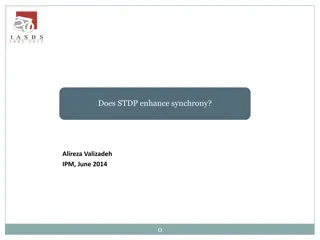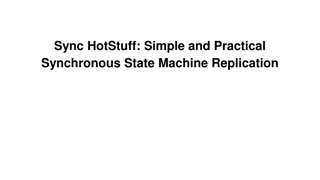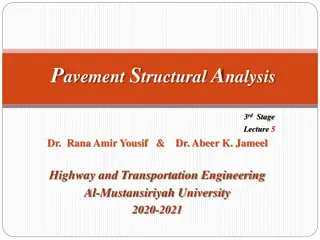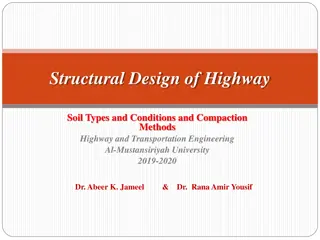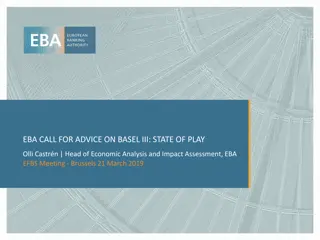
Granular Synchrony Timing Model
"Explore the granular synchrony timing model as a solution to current distributed system timing challenges. This model blends synchronous, partially synchronous, and asynchronous links to enhance fault tolerance and consensus algorithms."
Download Presentation

Please find below an Image/Link to download the presentation.
The content on the website is provided AS IS for your information and personal use only. It may not be sold, licensed, or shared on other websites without obtaining consent from the author. If you encounter any issues during the download, it is possible that the publisher has removed the file from their server.
You are allowed to download the files provided on this website for personal or commercial use, subject to the condition that they are used lawfully. All files are the property of their respective owners.
The content on the website is provided AS IS for your information and personal use only. It may not be sold, licensed, or shared on other websites without obtaining consent from the author.
E N D
Presentation Transcript
Granular Synchrony Authored by: Neil Giridharan, Ittai Abraham, Petah Tikva, Natacha Crooks, Kartik Nayak, Ling Ren Presented by J. Demore 2
Introduction - Timing models: - Synchronous: Message arrives before known upper bound - Partially Synchronous: Unknown, finite Global Stabilization Time (GST) - Network is Asynchronous before GST, Synchronous afterwards - Asynchronous: Messages arrive in any finite amount of time - Synchronous models consider sender or recipient faulty after a single violation Asynchronous protocol to tolerate even just a single crash fault must have an infinite execution [FLP Impossibility] Partially Synchronous models try to balance, but is too close to asynchronous with the same fault tolerance - - 3
Problem - Current distributed system timing models are too coarse grained - Synchronous / Partially synchronous / Asynchronous - Causes models to make assumptions that are too strong, or too weak - Consensus algorithms must still tolerate crash/Byzantine faults 4
Proposed Solution Granular Synchrony timing model - Modeled via graph - Mixture of synchronous, partially synchronous, and asynchronous links - Each of the three current timing models are extreme cases , this model servers as an intermediate between synchrony and partial synchrony. - CFT of f n/2, or BFT of f n/3, without full synchrony - Reaches consensus if conditions are satisfied within communication graph instead - Graph agnostic: does not assume knowledge of the graph - Digital signatures assumed for Byzantine Tolerances 5
Variants: Granular Partial Synchrony - CFT: iff quorum |n-f| nodes communicates synchronously - BFT: iff any set { n - 2f } correct nodes can communicate synchronously - Both require min f+1 nodes, despite faulty nodes 6
Variants: Granular Asynchrony - CFT - requires < n-f nodes outside largest connected component of graph following removal of crashed nodes, asynchronous edges - Passes FLP Impossibility in undirected graphs due to weaker conditions (discussed later) - BFT - requires a correct node, with partially synchronous paths to at least f correct nodes. - Deterministic BFT in graph agnostic algorithms only - Requires use of randomization - Does not consider algorithms that are not graph agnostic 7
Algorithm: Granular Synchrony [CFT] Round Robin leader selection, terminates after consensus reached by honest leader - Initially locked, and updates lock to current view and proposed value from leader, when leader does Propose - Every node sends STATUS message to leader, starts timer for view - Leader sends Propose after n-1 STATUS received. Status messages contain the view(v). Propose updates v to highest v received - Commits after n-f VOTE received, or single COMMIT, val - Single Commit due to CFT process, no Byzantines - Changes view after timer expires with no commit, sends NewView to other nodes requesting a view change. Waits for max 2d , which is worst-case round trip delay to send NewView and receive LOCKED 8
Algorithm: Granular Asynchrony [CFT] Can be adapted iff Theorem 5 and 10 hold (discussed later). Theorem 10 required for liveness as Async has no GST - Initially locked, each node broadcasts STATUS, view, lock to all, and forwards a set of all STATUS messages after receiving n-f. Starts 3d . Locks and votes for Proposal - View change requested if no Propose message received within 3d timer. Broadcasts ViewChange to all nodes. If n-f ViewChange for current view are received, sends NewView to all nodes, which is a confirmation of view change that updates the view. Other protocols follow Granular Synchrony 9
Algorithm: Granular Partial Synchrony [BFT] Extended from Granular Synchrony and Granular Asynchrony protocols, achieves external validity, but leverages graph condition of Theorem 10 to achieve f+1 tolerance. - View starts, each node sends STATUS to leader and starts view timer - Leader proposes after set S of n-f STATUS messages, of highest val - When a node receives Propose, checks if val is the highest in the set. Proposes this value and starts timer d to receive conflicting Propose within same view, which indicates faulty leader. - If faulty leader, ViewChange is proposed. - Otherwise, broadcasts VOTE-1 - Locks val, v as L and sends VOTE-2 after n-f VOTE-1. This redundancy guarantees locked value is unique. - Sends COMMIT after a set C of n-f VOTE-2, or commits and terminates if COMMIT, C received - View Change done if f+1 processes propose ViewChange, nodes stop sending VOTE-1 and VOTE-2, broadcasts Lock, and waits 2d to enter new view. Timer is sufficient for the lock broadcast to send/receive. 10
Algorithm: Granular Asynchrony [BFT] Similar to Partial Synchrony, with adapted Status and View Change steps - Adapts status to send to ALL nodes, vs. only Leader - Stores these as a set, and broadcasts set after n-f received. Starts 3d , then starts propose, vote and commit steps from previous. - Leader suspected faulty if no propose received before timer expires. n-f ViewChange must be received (Granular Partial Asynchrony is f+1 to initiate). Starts timer of 2d (Same as Granular Synchrony) 11
Algorithm: BFT with Unanimity Validity Unanimity is complete agreement by every pair of processors - In short, modifies the algorithm to lock in correct values before the first view starts - Uses a timer, receives inputs and unions the set of inputs. Forwards the set when timer to all. - When n-f forwarded input sets are received, locks the value if correct for f+1 messages 12
Definitions - D1: Synchronous Path. Node a has synchronous path to Node b, if there exists a sequence of synchronous edges (a, i1), (ik, b) where every intermediate node ijis correct. D2: Set of nodes A have a synchronous path to set of nodes B, if for every node b in B, there exists some node a in A such that a has a synchronous path to b. D3: Length of a path is the number of edges in it. If a has a synchronous path to b, the distance is the length of the shortest synchronous path between them. D4: Standard Consensus. Every node has initial input, must decide a value that satisfies agreement, termination, and validity. - - - 13
Theorems T5and T13specify the bounds for which a non-Byzantine set, A, and a larger non-Byzantine set, B, will maintain a synchronous or partially synchronous message bounds On the right, proof (Contradiction) supposes there would be an algorithm to solve CFT under disjoint sets. Here, (a) can agree v=1, while (b) and (c) could agree on v=0. 14
Theorems Proof by Lemma 6: No node will be able to commit a different value, since v (val) = v (val) - - Round-robin leader election means there is a correct leader eventually When nodes eventually enter view within time bound GST + 2d , all correct nodes will receive the message, vote, and commit within the view timer 4 15
Theorems - After removing asynchronous edges and faulty nodes from the graph, followed by removing the largest connected component, there are fewer than n-f nodes. This restriction circumvents FLP Impossibility - 16
Theorems - These are all fairly intuitive following the others. 17
Theorems 18
Thank You! 19











